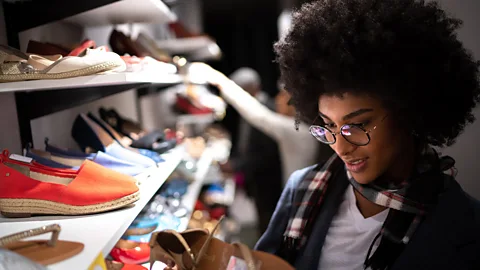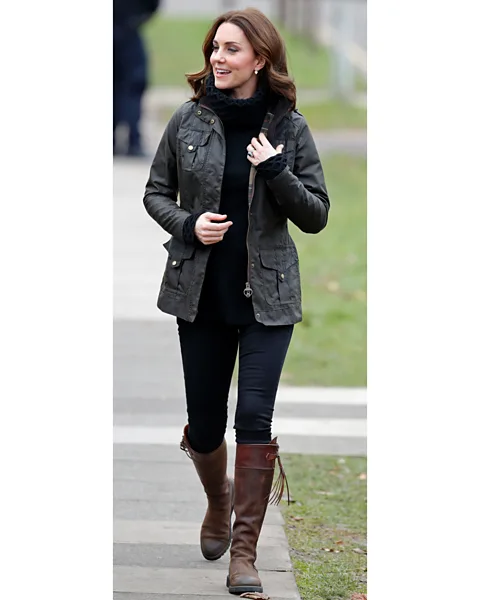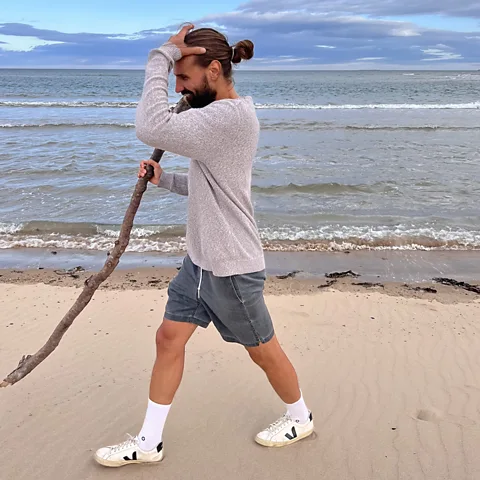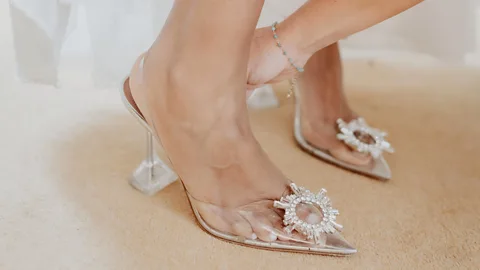By Ana SantiFeatures correspondent

 Getty Images
Getty Images
From Princess Kate’s favourite riding boots to the most sustainable sneakers, what is the best way to choose shoes – and how can we make our footwear last for decades?
How long does a pair of boots last? For the Princess of Wales, nearly two decades and counting. Her favourite tassled riding boots by Penelope Chilvers recently featured in Netflix’s The Crown worn by the young student Kate (played by Meg Bellamy) at university. They were first worn in public by Kate Middleton in 2004, and are still her go-to boots for countryside engagements.
If well-made and well looked-after, footwear can last for decades, and retain its value. When she was a bride-to-be, Wassima Gamal dreamed of wearing “Cinderella” shoes on her wedding day. Designed by Amina Muaddi, the glass-like slingbacks, with their crystal-embellished brooch and distinctive fluted heels, retail for around £850 ($1,080). Already over-budget and conscious that she’d probably only wear them once, Gamal wondered if there was an alternative to buying a new pair. Enter her fairy godmother: By Rotation.
More like this:
She found the slingbacks in her size on the app-based, peer-to-peer rental service. “It was my first time renting so I didn’t know what to expect, but the process was fairly easy,” she explains. “I had to send a request to the lender – I remember waiting for their response with bated breath. Thankfully they accepted, and I was ecstatic. The next stressful part was waiting for the shoes to arrive – and they did, a day or two before the actual renting start date, which I was so grateful for.”

 Getty Images
Getty Images
Gamal says she was “naturally careful” to ensure the shoes didn’t get damaged – and therefore incur any additional charge beyond the £103 ($133) for three days – but she was reassured by the transparency of lenders and customers on By Rotation. Each customer has a profile and, if applicable, a verified user status (showing they are an experienced renter with ratings). By Rotation also facilitates its lenders in the case of any damage, loss or theft with reimbursement for the cost of repair.
My approach to footwear – and lifestyle in general – is to find utility over fast fashion – Jack Seymour
Rental is one of the ways of keeping fashion items in circulation, helping to curb excessive production and consumption of new products. According to sustainability consulting group Quantis, footwear production accounts for one-fifth of the fashion industry’s environmental impact and generates 1.4% of global carbon emissions, with manufacturing and raw material extraction the biggest drivers. And we’re making a lot of shoes: 23bn pairs globally each year, with the United States having the highest demand for footwear at 6.98 pairs per person. To top it off, 90% of shoes end up in landfill.
“My approach to footwear – and lifestyle in general – is to find utility over fast fashion,” says surfing and sustainability enthusiast Jack Seymour, who lives in Northumberland in the UK. “My favourite items to repair are my surfboards. They give me so much joy and, much like my shoes, have to withstand testing conditions. I believe in buying well in the first instance from respected brands with decent values, and then take every opportunity to repair first – if anything, the more worn-in, the better the shoes feel. With fashion moving quicker each season, there is always a new item out there before you have had a chance to even get the soles dirty.”

 Jack Seymour
Jack Seymour
Seymour conducts a trainer “MOT” twice a year: a deep hand-clean, taking care to thoroughly dry them properly afterwards by filling with newspaper, and, if required, a new pair of insoles. A change of laces, he says, not only help to keep trainers looking fresh, but can also alter the style and make them feel almost new. For maintenance of his formal shoes, Seymour goes to a local cobbler (shoe mender).
His wife, Emily Carter, says her approach to sourcing and buying shoes has changed in the past five years. Instead of replacing a pair of shoes that are too tight, for example, Carter stuffs newspaper as tightly as possible into the shoe overnight. She also has shoe stretchers to hand. “Repairs are definitely not always the cheaper option, but that incentivises me to buy higher quality items, which should need fewer repairs and feature robust materials that can withstand multiple repairs if and when needed,” she says.
“I’ve paid about £65 for a Dr Martens resole before, but heel replacements cost between £10 and £15, which is a far more cost-effective way of maintaining a shoe.” Carter points to a pair of white Veja trainers – more than four years old, they’ve been maintained with leather protector, damp-sponge cleaning and smartened up with a fresh pair of laces. “And a pair of Converse has survived many festivals and holds far too many memories to ever part with,” she says. “They’ll be passed down like a family heirloom!”
Repair and recyle
In June 2020, French sneaker brand Veja opened a repair and recycling project store in Bordeaux that sells never-launched Veja prototypes, trainers with minimal defects at a reduced price, and features an in-store cobbler to repair all trainers – Vejas and those from other brands. Trainers that cannot be repaired go into a recycling box.
The cost to the planet
The idea for the store was four years in the making. “We started working on a Veja recycling programme, and we realised that people were throwing away shoes that weren’t done yet,” says co-founder Sébastien Kopp. “People were bringing us their old Vejas to be recycled and we said: ‘Wait, they just need proper cleaning!’ So we thought, maybe there’s a step before recycling: repair.”
Only 13.6% of clothes and shoes thrown away in the US end up being recycled, with footwear making up a small fraction of that. “So we asked ourselves: what if we could extend the life cycle of the shoe?” says Kopp. “That’s when we decided to become cobblers – for all shoes.”
US fashion brand Reformation, which collaborated with Veja on a sneaker collection in October, initially launched footwear in 2019 but then paused production until 2021 to ensure it met the brand’s standards, with a new supply chain based in Brazil. “As part of this process, we also reduced the amount of virgin plastic used in our footwear by 75% through bio-based alternatives, and expanded supply chain traceability to the farm level,” explains chief innovation officer Alison Melville.

 Getty Images
Getty Images
Reformation, a founding member of the non-profit Footwear Collective, also runs a recycling programme with Looptworks in Portland, which recycles 100% of Reformation shoes. “There are very few options for recycling shoes given the number of components, types of materials used and associated costs,” says Melville. “We encourage our customers to keep their shoes in use as long as possible before recycling them.”
Buying second-hand or renting for special occasions make high-quality footwear more widely accessible
London-based writer Emma Firth favours vintage, using online platforms like Vinted. “I’ve mostly been selling my own stuff, but in terms of buying on the platform, I seek quality, hard-wearing pieces,” she says. “I needed some black ankle boots that could look just as good with a vintage men’s suit or a mini-dress to the pub. I was toying with a pair of gently worn Isabel Marant Western boots but in the end I opted for an entirely new Rag & Bone Chelsea boot style, listed at £110 and retailing for about £375. I offered a slightly offensive £70, knowing she’d meet me somewhere in the middle (my mum taught me the art of haggling young). She did, at £90. Dig hard enough and affordable designer stuff will prevail.”

 Wassima Gamal
Wassima Gamal
Buying second-hand or renting for special occasions make high-quality footwear more widely accessible. Second-hand enthusiast Lucinda Devenish’s leather walking boots are another case in point. She first bought a pair of thrift-store shoes nearly 20 years ago. “Buying new doesn’t make sense to me; becoming more aware of how much the fashion industry produces in terms of carbon emissions was critical to my decision making,” she explains. “And there are advantages to your wallet, too. I bought a pair of leather Scarpa walking boots that cost £5 [$6.30] in a charity shop in Oxford – it would have cost almost £200 [$254] new. They lasted me for another 10 years. Be flexible in what you are looking for and don’t feel that you need to find the latest trend. Try to know your size in different brands and styles.”
These methods of sourcing and prolonging shoes aren’t new. Emily Carter attributes her set of values to her father’s own. “He is from a generation that didn’t replace items at the drop of a hat and has a military background, where shoes had to be kept in perfect condition for uniformity and discipline,” she recalls. “He owns beautiful pairs of leather shoes that have been maintained for literally decades, and have acted as a reminder to view mine with the same value and care.”
Three Things to Help Heal the Planet by Ana Santi is published by Welbeck Balance
If you liked this story, sign up for The Essential List newsletter – a handpicked selection of features, videos and can’t-miss news delivered to your inbox every Friday.
Sign up to the Future Earth newsletter to get essential climate news and hopeful developments in your inbox every Tuesday from Carl Nasman. This email is currently available to non-UK readers. In the UK? Sign up for newsletters here.





